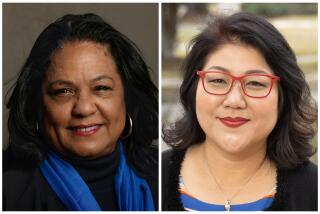Growth Again Election Issue in Culver City : Politics: Mayor Jozelle Smith is one of three candidates running for two City Council seats. Competing measures that would set building limits will also be on the ballot.
- Share via
Two years ago, growth was the major issue in a campaign that saw nine candidates run for three City Council seats in Culver City. This year, voters will get a replay of the issue as three candidates vie for two seats.
Also competing against each other are two ballot measures, one to limit building height and the other to impose density controls on buildings over a certain height.
The candidates are Mayor Jozelle Smith and newcomers Mike Balkman and Tom Hammons. Richard Alexander, a four-term councilman, decided not to run for reelection, citing personal reasons, including a desire to travel. He said he endorses Balkman and Smith.
Although slow-growth forces consider Balkman as pro-development and pro-business, he likes to talk in terms of “balanced . . . renewal.”
“Growth means that you’ve got land and can expand on it. We don’t have a lot of that in Culver City,” said Balkman, the 36-year-old president of an electrical contracting company and a member of the Culver City Chamber of Commerce board of directors. Instead, he said, “you take an area that’s older, and renew it by putting new things on it. That has to be balanced between residential and commercial.”
Hammons, 51, is a district manager for Thrifty Drug Stores. He is backed by Councilmen Steven Gourley and Jim Boulgarides, who trumpeted slow-growth when they defeated incumbents in 1988.
Smith said she is running on her record of the past four years, which includes “promoting our responsible growth, even though Los Angeles is going wild with free-wheeling developments all around us” and “cooperation with the business community.” Smith, 50, is an insurance agent and a columnist for a local newspaper.
Voters in the April 10 election will also decide on the two competing measures, one proposed by the City Council and the other the result of a citizens’ petition drive. Should both measures pass, the one that gets the most votes will take effect.
The voters’ initiative specifies only a limit on height--56 feet (about four stories)--in certain commercial zones. Slow-growth advocates collected nearly 3,000 signatures in 1988 to qualify it for the ballot. The vote would have been taken sooner if more signatures had been gathered.
An interim ordinance that expires on Election Day limits the height of buildings to 58 1/2 feet, with an additional 13 1/2 feet allowed for architectural features and mechanical or electrical equipment.
The council’s measure would impose a limit on how much of a lot could be covered by a structure and create traffic-mitigation requirements for any non-residential buildings taller than 43 feet. Such buildings would also be prohibited from blocking views or causing “significant detriment” by their shade, shadows or glare.
The city attorney has said that if the council proposal wins, the height limit would revert to that in the Zoning Code: 167 feet (12 stories).
Robin Turner, a sponsor of the citizens’ measure, attacks the council version as having no built-in height limit, saying it leaves too much up to the council. “It’s at all their own discretion what’s going to give shadow (and block) views.”
She said the council put its proposal on the ballot only to “discredit ours. . . . It’s a total disregard of what the citizens’ wishes are.”
Hammons agreed, saying the council version would allow “three people only (on the five-member council) . . . to approve a building (167 feet) tall, . . . regardless of the public’s sentiments.”
But Smith said this was unlikely. “I can never envision 167 feet in my lifetime because we don’t have that kind of open space.” A building that tall must still meet setback and other requirements, she said.
She and Balkman said the citizens’ initiative lacks flexibility. “It’s impossible to project what kinds of land uses might come before us down the road, where we may want to go higher than 56 feet,” Smith said.
The council’s measure, she said, is more comprehensive because it includes criteria besides height. But Turner and Hammons argue that those considerations are handled by strict setback, parking and other requirements that the city already has.
All the council candidates agree that downtown, where Washington and Culver boulevards cross, needs some sort of master plan. Smith and Hammons speak of a “pedestrian-friendly” area with shops and restaurants. Balkman called the downtown a “run-down” mishmash.
“We’ve got Filmland (Corporate Center),” a modern glass edifice, “and virtually across the street, (the Spanish-style) Meralta Plaza,” he said. “Those buildings don’t fit at all with each other.”
The three candidates also pledge to fight traffic gridlock. “This is one of the worst laid out cities in terms of traffic and roads,” Balkman said, saying the streets are too narrow and complaining about the Los Angeles traffic that cuts across Culver City’s main arteries.
Culver City’s relationship with surrounding Los Angeles came to the fore again recently with the Culver City’s Planning Commission’s approval of Marina Place, a proposed regional mall at the western edge Culver City. Los Angeles officials are objecting to the project because of anticipated problems with traffic, noise and pollution.
The approval came despite findings that the mall, similar in size to the Westside Pavilion, would burden nearby intersections, hamper access to the beach and lead to unhealthful levels of air pollution. Culver City will net an estimated $2.5 million a year in taxes and business license fees should the mall be built. The City Council is expected to consider the mall’s plans by early March.
Balkman and Smith said they support the project as is, with Balkman saying that “any project is going to have some negative.”
“We’ve honestly tried to mitigate it the best we can,” Smith said. “I don’t think we’re thumbing our nose at L.A.”
Hammons, however, said the project should be scaled down, saying, “I think of it as if I were living there.” Cutting its size by 25% would still produce plenty of revenue for the city, he said.
Hammons said his candidacy stems from three years ago when the council “(imposed) its will on my (Sunkist Park) neighborhood” and erected barricades to solve traffic problems there. After an outcry by residents, the council reversed itself, but then installed stop signs and turn restrictions.
“I want to see that we prevent the government from imposing on another neighborhood,” said Hammons, a member of the Culver City Homeowners Assn. He also is a member of council-appointed committees on the Studio Drive-In site and on sign ordinances. He will promote the need to improve parks and recreational facilities, he said.
Balkman, who sent surveys to registered voters to get input on issues, agrees with Hammons that communication between residents and city government is inadequate. The city should write synopses of upcoming council and Redevelopment Agency agendas and have them printed in local newspapers, he said. The City Council, he said, has to be more fiscally responsible and ask common sense questions.
Balkman is the president of the Culver City Lions Club and a member of the Culver City Homeowners Assn. He said the city should help the school district with security, maintenance and by donating equipment.
Smith argues that City Hall has already had an open door, to the extent of getting criticized for “involving citizens too much, where a simple grab-the-bull-by-the-horns-and-council-make-a-decision would be the right or proper thing to do.”
She is pleased with the revamping of Studio Village shopping center but decries the number of mini-malls in the city. But, she added, “it’s unrealistic to think we can only attract Beverly Hills-type shops because we’re not a Beverly Hills neighborhood.”
City Clerk Pauline Dolce is running unopposed for another four-year term.
More to Read
Sign up for Essential California
The most important California stories and recommendations in your inbox every morning.
You may occasionally receive promotional content from the Los Angeles Times.













